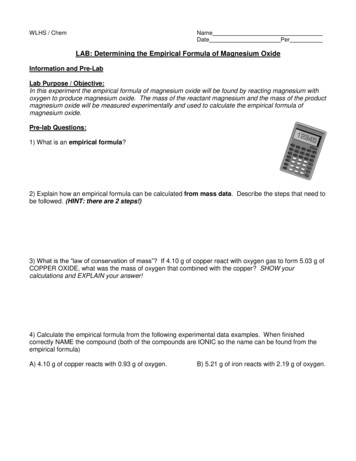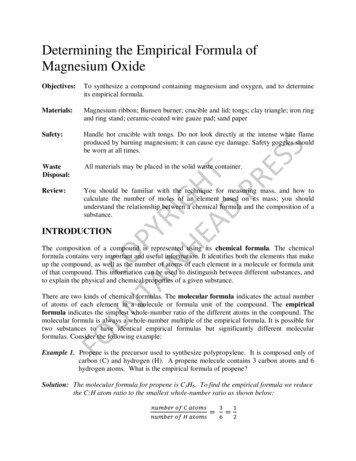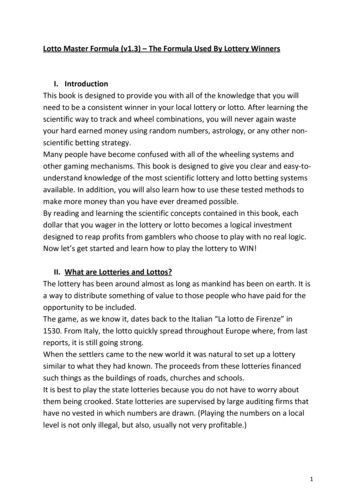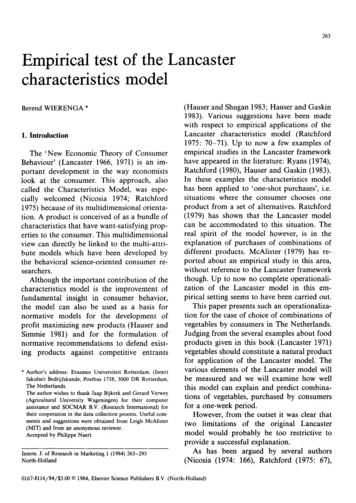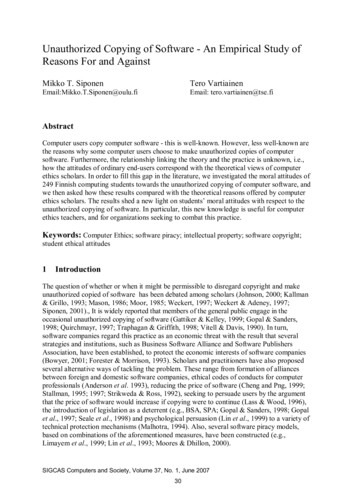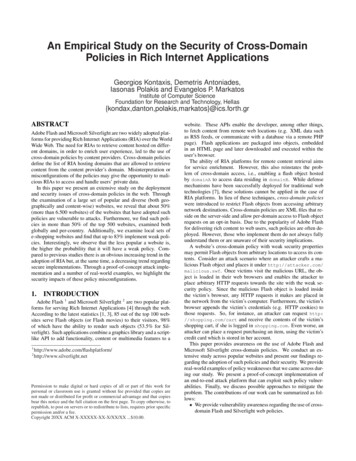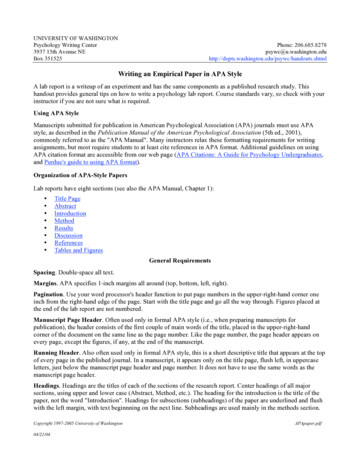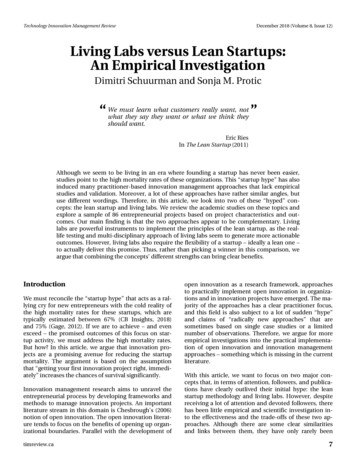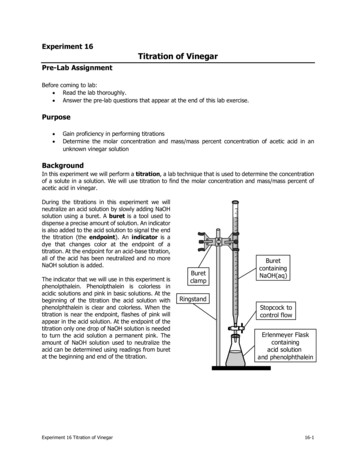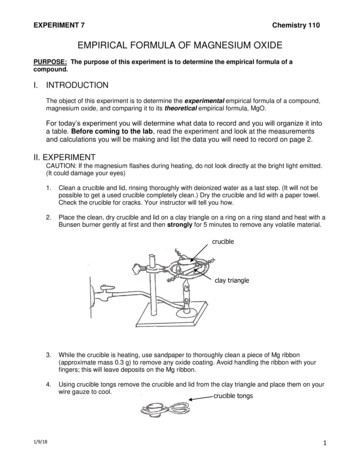
Transcription
EXPERIMENT 7Chemistry 110EMPIRICAL FORMULA OF MAGNESIUM OXIDEPURPOSE: The purpose of this experiment is to determine the empirical formula of acompound.I. INTRODUCTIONThe object of this experiment is to determine the experimental empirical formula of a compound,magnesium oxide, and comparing it to its theoretical empirical formula, MgO.For today’s experiment you will determine what data to record and you will organize it intoa table. Before coming to the lab, read the experiment and look at the measurementsand calculations you will be making and list the data you will need to record on page 2.II. EXPERIMENTCAUTION: If the magnesium flashes during heating, do not look directly at the bright light emitted.(It could damage your eyes)1.Clean a crucible and lid, rinsing thoroughly with deionized water as a last step. (It will not bepossible to get a used crucible completely clean.) Dry the crucible and lid with a paper towel.Check the crucible for cracks. Your instructor will tell you how.2.Place the clean, dry crucible and lid on a clay triangle on a ring on a ring stand and heat with aBunsen burner gently at first and then strongly for 5 minutes to remove any volatile material.crucibleclay triangle3.While the crucible is heating, use sandpaper to thoroughly clean a piece of Mg ribbon(approximate mass 0.3 g) to remove any oxide coating. Avoid handling the ribbon with yourfingers; this will leave deposits on the Mg ribbon.4.Using crucible tongs remove the crucible and lid from the clay triangle and place them on yourwire gauze to cool.crucible tongs1/9/181
5.Allow the crucible and lid to cool completely to room temperature and then weigh themtogether. Handle the crucible with tongs, so you do not leave any deposits from your fingers.6.Coil the Mg ribbon very loosely and place it inside the crucible at the bottom. Put the lid on thecrucible and then weigh the crucible with Mg.7.Place the lid on the crucible. Heat the crucible gently for 5 minutes. (Think about which partof the Bunsen burner flame is best for heating gently.) Use your crucible tongs to lift the coverslightly every 30 seconds to admit air. If the Mg starts glowing brightly when the cover is lifted,quickly cover the crucible, remove the Bunsen burner, and wait one minute before continuingto heat.8.Heat the covered crucible strongly for 15 minutes, lifting the cover occasionally.9.Lift the lid and look at the ribbon to see whether it has become a whitish ash. If the ribbon stillhas its original color, reheat for 10 more minutes. Continue heating, as necessary, tocompletely react the ribbon, then allow the crucible to cool.10. To the contents of the cooled crucible, add 10 drops of deionized water.11. Partially cover the crucible (leave a slight crack) and heat gently for 2 minutes, then heatstrongly for 10 minutes. Allow the crucible and contents to cool to room temperature.12. Weigh the crucible and contents (magnesium oxide).13. Reheat strongly (5-10 minutes), cool completely and weigh. Dry the magnesium oxide to aconstant mass, repeating the heating until the mass is constant to within 0.2 g.HEATING TO A CONSTANT MASSYou cannot tell by “looking” at the sample whether or not it is really dry. Therefore, you will “dry toa constant mass”. To do this you will heat the sample until it looks dry, allow it to cool, and thenweigh it. You will then reheat the sample, allow it to cool, and then reweigh it. If the mass haschanged significantly upon reheating, your will heat the sample, cool and weigh a third time. Youwill continue in this fashion until two consecutive weighings yield similar masses. This is the onlyway to know that all of the water has been removed.*Do not dispose of your sample until you have shown your instructor your results.* DISPOSAL: Dispose the product in the waste container labeled "waste magnesium oxide"PREDICTION: Complete this sentence before you start the experiment:I think the mass of the magnesium in this experiment will (increase, decrease, or remainthe same)The reason I think this is because:1/9/182
DATA LISTBelow, list the data you will need to record. Then on page 5 draw your data table.1/9/183
III. CALCULATIONSIn the spaces below write the set-ups, including all units and labels, of the calculations. Use thefollowing molar masses: magnesium 24.305 g/mole; oxygen 15.999 g/mole1. Mass of Mg2. Mass of magnesium oxide.3.Mass of oxygen that reacted with Mg.4.Moles of Mg5.Moles of oxygen6.Experimental empirical formula of magnesium oxide7.Theoretical empirical formula of magnesium oxide1/9/184
Report Experiment 7EMPIRICAL FORMULA OF MAGNESIUM OXIDEChemistry 110 LabName Date(last)(first)Instructor's InitialsI.DATA TABLEDraw your data table below. Be sure to use a ruler to draw the table and use appropriate headingsfor columns and rows. Make sure you include units.1/9/185
III. CALCULATIONSGive complete set-ups including all units and labels. Be sure your significant figures are correct.Use the following molar masses: magnesium 24.305 g/mole; oxygen 15.999 g/mole1. Mass of Mg.2. Mass of magnesium oxide.3.Mass of oxygen that reacted with Mg.4.Moles of Mg.5.Moles of oxygen.6.Experimental empirical formula of magnesium oxide.7.Theoretical empirical formula of magnesium oxide.1/9/186
IV. QUESTIONS:Give complete set-ups including all units and labels. Be sure your significant figures are correct.1.The percent by mass composition of a salt was found to be 56.58% potassium, 8.68% carbon,and 34.73% oxygen. What is the empirical formula of this salt?2.A compound containing iron and sulfur was formed by combining 2.233 g of iron with 1.926 gof sulfur. What is the empirical formula of the compound?1/9/187
3. Propylene has a molar mass of 42.00 g/mole and is composed of 14.3 % hydrogen and 85.7% carbon. What is the molecular formula of propylene?4.1/9/18Compare the mass of the Mg ribbon with the mass of the magnesium oxide. Notice that themass of the magnesium oxide is greater than the mass of the Mg. How do you account for thisapparent increase in mass?8
The object of this experiment is to determine the experimental empirical formula of a compound, magnesium oxide, and comparing it to its theoretical empirical formula, MgO. For today’s experiment you will determine what data to record and you will organize it into a table. Before coming to the lab, read the experiment and look at the measurementsFile Size: 253KBPage Count: 8
